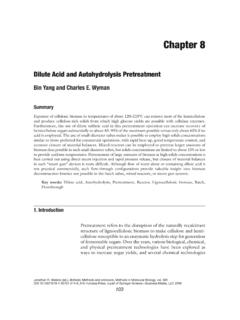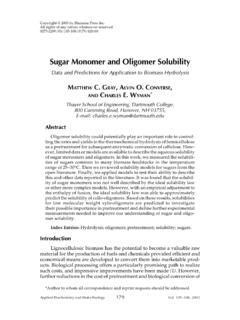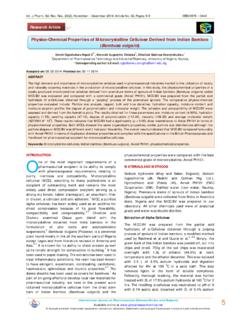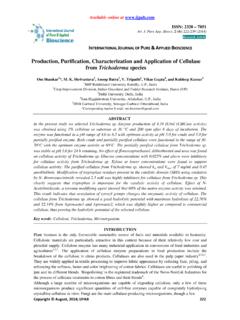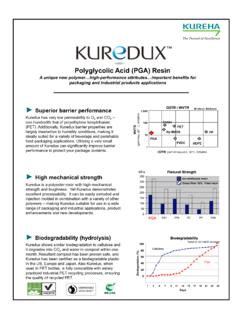Transcription of Development of New Cellulose-based Polymers …
1 Development of New Cellulose-based Polymers with Excellent Melt- processability Daisuke SAWAI*, Yutaka NOZOE*, Toshihide YOSHITANI*, and Yoshihisa TSUKADA*. Abstract New Cellulose-based Polymers with excellent melt-processability have been developed. The effects of molecular size, functional groups and the degree of substitution on the mechanical and thermal properties of Cellulose-based Polymers were studied. Plasticity improved markedly with the size and number of added substituents. It was found that the balance between mechanical properties and plasticity was improved dramatically by the combined use of small and large molecules added to side chains. Furthermore, the impact strength of Cellulose-based Polymers was increased by the addition of ether/ester groups together.
2 These results correlated with the degree of prevalence of soft segments as estimated from dynamic mechanical analysis and solid-state 1H NMR, and such a specific effect is reported here for the first time. Injection molding of this material was carried out, and good rheological and processing characteristics were confirmed. 1. Introduction based Polymers alone is still insufficient. Under such circumstances, focusing on the unique Nowadays, there is increased interest worldwide in the property of cellulose , the industry has been vigorously Development of materials to support a sustainable society working on the improvement of cellulose materials by by reducing environmental load. Conventionally, in the utilizing denaturation. In recent years, some case examples manufacture of products, the polymer chemical industry have been reported, such as the commercialization of melt- was completely dependent on materials originating in spun fibers with thermoplastic-enhanced, Cellulose-based fossil resources.
3 However, the industry is now striving polymers3); and the Development of strong, thermoplastic to develop recyclable materials with biomass. As such Cellulose-based Polymers with excellent water and heat materials, polylactic acid (hard type) and polybutylene resistance from acetylcellulose with cardanol (a main succinate (soft type) have been commercialized, but the ingredient of cashew nuts) grafted on4). expectation for the Development of even higher-performance, In the meantime, we reached the idea of developing higher-functionality plastic originating in biomass has been high-perfor mance biomass plastic materials having increasing1). excellent thermoplasticity from Cellulose-based Polymers by Among biomass, cellulose has vast output and thus controlling their strong hydrogen bonds within and between stable supply can be expected.
4 However, it is a self-cohesive molecular chains. energy, non-thermoplastic material, having very strong Thus, we developed new strong, Cellulose-based Polymers hydrogen bonds within and between molecular chains. To with excellent thermoplasticity and heat resistance. In this add thermoplasticity to cellulose materials, the following paper, we explain their capabilities and report the results two methods have been discussed: external plasticization of investigations of their applicability as injection molding utilizing the denaturation of hydroxyl groups in combination materials. with plasticizers; and internal plasticization utilizing the denaturation solely. Acetylcellulose and nitrocellulose are 2. Thermoplasticity and Mechanical Cellulose-based Polymers with low molecular plasticizers Properties of New Cellulose-based added that can be produced using the former technique.
5 Polymers On the other hand, cellulose acetate propionate and On considering the thermoplasticity of new cellulose - cellulose acetate butyrate are materials made with the base Polymers , we focused on the following factors: binding latter technique2). However, in spite of the above-described species, molecular sizes and the degree of substitution. Development activities, the thermoplasticity of cellulose - Among them, it is molecular sizes and the degree of Original paper (Received November 18, 2011) substitution that are directly related to the control of the * Synthetic Organic Chemistry Laboratories hydrogen bonds of cellulose . Binding species function to Research & Development Management Headquarters FUJIFILM Corporation Nakanuma, Minamiashigara, Kanagawa 250-0193, Japan FUJIFILM RESEARCH & Development ( ) 55.
6 0 <Substituent A> <Substituent B> <Molecular form> Substituent Press film ether ether Aromatics CH3. Non-thermoplastic area cellulose GPa,86%. ester ester Ring OH MC EC . Carbon Carbonate Carbonate Branch number HO. O. O. CH2CH3. ,68%. OH n GPa,68% ,60%. O. Straight C CH3 CA CA . Carbamate Carbamate ,63%. chain O GPa,53% ,39%. C CHCH2CH2CH2CH3. ,53% Thermoplastic area CH2CH3 2Eh-Cell 2Eh-Cell . Fig. 1 Examples of the combinations of substituent/molecular * Values indicate modulus (GPa) and the proportion of plant-based substances (%). form added to cellulose . Fig. 2 Plasticity of Cellulose-based Polymers modified by one Plasticization behavior of Cellulose-based Polymers modified by one functional group. functional group. change the rigidity of portions connected to cellulose .
7 Fig. 1 we considered modification in the higher-order structure illustrates the idea of binding species and molecular sizes that achieved by the substitution of three hydroxyl groups in the we considered. cellulose repetition cycle. Then, we designed Polymers with a method in which binding species, molecular sizes and the Properties of Cellulose-based Polymers degree of substitution were combined within the chemical Denatured with A Single Substituent structure, incorporating molecular motion in the cellulose We first considered the impact of molecular sizes and the molecular form (higher-order structure) and side chains degree of substitution on the expression of thermoplasticity during the modification. and discovered that those factors are closely related to it.
8 As Fig. 4 shows the dependence of modulus on the degree shown in Fig. 2, using bulky substituents was more effective of substitution in the cases where the following materials to enhance thermoplasticity, and binding species had an with multiple substituents were used: a combination of the influence on the mechanical properties of the new cellulose - methyl group and the 2-ethylhexanoyl group (MC-2Eh); and based Polymers . Fig. 3 exemplifies the relationship between a combination of the acetyl group and the 2-ethylhexanoyl the degree of substitution and glass transition temperature of group (CA-2Eh). Compared with the case where materials materials that have molecule sizes of four-carbon atoms and with the single substituent 2-ethylhexanoyl (Cel-2Eh). eight-carbon atoms.
9 The use of bulky substituents promoted are used, materials with multiple substituents expressed the expression of thermoplasticity but it also tended to thermoplasticity in the high modulus area and had a better soften the Polymers . That means, to balance the mechanical balance of material performance. In this way, they exhibited performance and melt moldability of Polymers , controlling performance that materials with a single substituent cannot molecular sizes and the degree of substitution alone is not achieve. In addition, further consideration of various sufficient. combinations of substituents found that specific substituent 170 combinations exhibit an excellent balance of rigidity, impact resistance and heat resistance, based on which Article A was developed.
10 The results of an analysis of newly discovered Glass transition temperature ( C). 150. materials retaining excellent performance balance are 130 described in the following paragraphs. 110. Combination 90. Tensile modulus (GPa). 70. Degree of substitution Single Glass transition temperature as a function of substitutions Blue and red symbols correspond Fig. 3 Glass transition temperature as a function of substitutions. to 4 ( ) and 8 ( ) of carbon number. Blue and red symbols correspond to 4-carbon ( ) and 8-carbon ( ) additions. Degree of substitution of the 2-Eh group Properties of Cellulose-based Polymers Tensile strength as a function of substitutions modified by 2Eh for MC-2Eh ( ), CA-2Eh ( ). Denatured with Multiple Substituents Fig. 4 Tensile strength as a function of substitution; modified by and Cel-2Eh 2Eh( ).










